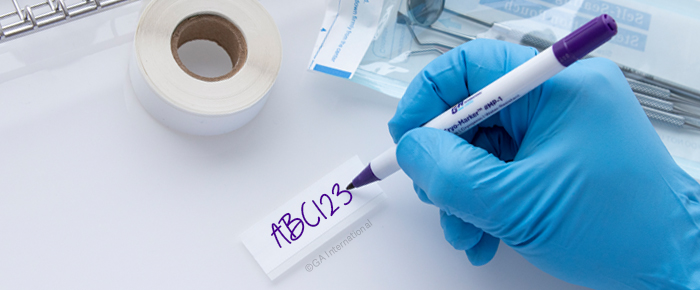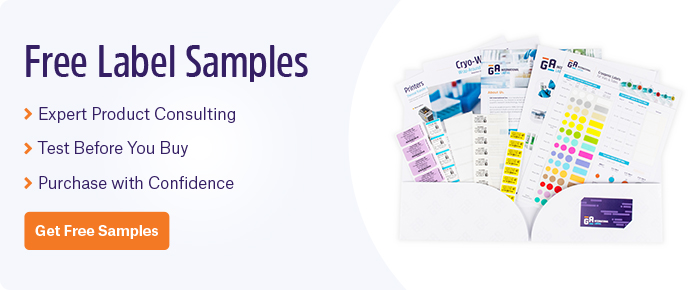
This blog may be controversial. If you are a subscriber of our blog, you already know about our contempt for handwritten labeling. They are the source of sample mismanagement in the lab. We will always encourage the use of printed and barcoded labels for error-free sample management. Nevertheless, there remains a significant number of labs that handwrite to identify their samples and equipment. This is particularly true in academia, where a limited budget can make it the only real option. Thus, while handwriting labels is not ideal, we understand that it may be the only option currently available. So, if you will use handwriting for identification purposes, we recommend these six solutions to maintain a high standard of accuracy.
Permanent markers
When you write on your vials, tubes, or boxes, ensure you use permanent markers and not pens or pencils. Permanent markers are less likely to or smear than pens, and the writing will remain legible for longer than a pencil, which can fade. Permanent markers are available in various formats, allowing you to choose a marker that fulfills your particular function. This can include cryogenic and alcohol-resistant markers. Cryo-Markers are an excellent solution for containers that will be stored in low-temperature freezers, while alcohol-resistant markers should be used to identify containers that will be regularly decontaminated with alcohol sprays, such as cell culture media and flasks.
Color-coding
Another tip that can help to keep your lab organized is color-coding. You can get rolls of color tape for a reasonably low price in a variety of different colors. Each color can then be assigned a specific meaning, making visual identification of samples and material faster and easier. This can be used in various ways, including color-coding material according to the user, application, or even differentiating reagents. For example, this can be used by labs that use multiple different restriction enzymes, various PCR oligos, or even to identify multiple different antibodies used in westerns.
Color-coding can also be done using writable color dots, making labeling small vials and tubes easier, as they are designed to be applied on tube caps and tops. Color dots and writable color tape can be used in your notebook to make finding specific experiments easier or to mark important sections in your lab book for reference. Using a color code can also help deal with poor handwriting that is often a problem in laboratories. The color can notify you about the containers’ contents, even if the writing is not entirely legible.
Pre-printed laboratory labels
When using handwriting to identify containers, we recommend using laboratory labels that come color dots with dedicated sections and headings that the user can fill in. These pre-printed labels come in various formats designed for specific applications. This includes calibration labels for regularly inspected or calibrated equipment, solution labels for frequently prepared buffers that note preparation data, storage conditions, and pH, as well as warning labels that can be used to identify material that should not be used or containers that have been opened.
These pre-printed laboratory labels can also be customized to your unique specifications to include the exact sections you need. Using labels with defined sections, including lines where information can be recorded, makes writing easier. They can be inscribed on a flat surface prior to application and provide designated areas for writing, so the user has a guidepost when writing. They also make reading the information more straightforward, as the labels at least provide a context when trying to decipher the writing, making even poor handwriting a little easier to read.
Self-laminating labels & tape
Using handwritten identification can become a real problem in cases where your containers will be exposed to harsh environments or conditions. In such cases, we suggest using self-laminating, as they have a clear laminate that is applied over your writing, protecting it from harsh chemicals, extreme temperatures, as well as abrasion, and physical damage.
There are two types of self-laminating labels that can be used, wrap-around labels and laboratory labels with a clear flap that is applied over the label. Wrap-around labels are ideal for identifying vials and tubes that will be stored in low temperature conditions. These cryogenic labels should be inscribed using cryo markers and are perfect for long-term storage, even in liquid nitrogen. Labels or even tape with a lamination flap are a great resource when identifying equipment and material that undergoes regular wear-and-tear or is exposed to harsh chemicals and solvents. They can be used as chemical-resistant lab labels, protecting your written information from chemicals such as xylene, alcohols, acetone, DMSO, and bleach. Self-laminated perforated tape can produce on-demand laminated labels and tags perfect for a variety of applications.
GatorCUT tapes
Labs that use writing to identify samples and containers will often also use tape as a means to identify their containers. This usually involves cutting a piece of tape and writing on it. However, most tapes require the use of a dispenser or scissors to get a clean-cut, restricting their use to certain areas of the lab, or making you keep a pair of scissors handy at all times.
GatorCUTTM tapes resolve this issue by being effortlessly hand-cuttable. This makes them convenient for use throughout the lab, wherever and whenever they are required. These handy tapes are offered in a range of colors for added color-coded identification. GatorCUT tapes also come in cryogenic formats, making them suitable for low temperature storage, and ensuring they won’t peel or detach during storage, which can be a problem with traditional lab tapes. They are also available in static-cling formats in case a non-adhesive option is required.
Tips for Improving Your Writing
Finally, if you are going to be writing, make sure your writing is legible. This means improving your technique and following a few simple rules.
- Choose the right marker: Ensure you’re using the right marker for the job and your comfortable using it.
- Pick the right surface: Writing directly on the container can often be challenging due to its curved surface or limited writing area. As such, always write on a label or some tape, and never on the container. This will often increase your writing area and allow you to write on a flat surface before applying.
- Slow down: Don’t rush when you’re writing, as this can often lead to poor writing.
- Examine your writing: Determine what letters you have difficulty with and work on improving those.
LabTAG by GA International is a leading manufacturer of high-performance specialty labels and a supplier of identification solutions used in research and medical labs as well as healthcare institutions.




